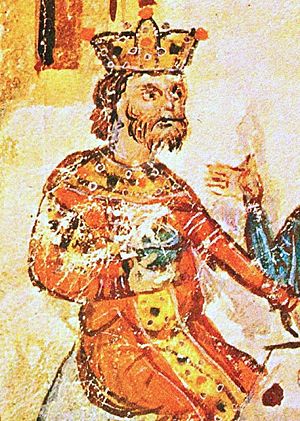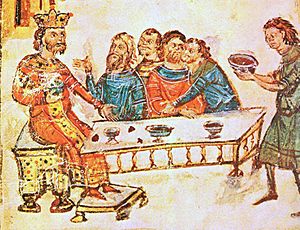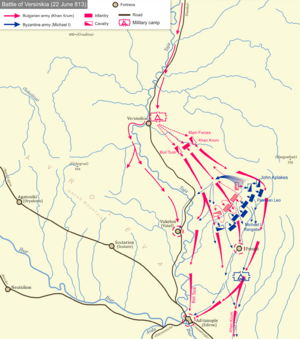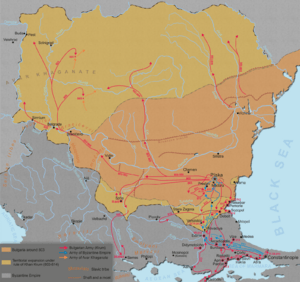Krum facts for kids
Quick facts for kids Khan KrumХан Крум |
|
|---|---|
| Khan of Bulgaria | |

A 14th century depiction of Krum
|
|
| Reign | 803–814 |
| Predecessor | Kardam |
| Successor | Omurtag |
| Died | 13 April 814 |
| Spouse | Unknown |
| Issue | Omurtag Budim |
| House | "Krum's dynasty" (possibly Dulo) |
| Religion | Unknown, Probably Tengrism |
Krum (Bulgarian: Крум, Greek: Κρούμος/Kroumos), often called Krum the Fearsome, was the Khan of Bulgaria. He ruled from around 796 or 803 until he died in 814. During his time as ruler, Bulgaria grew much bigger. Its land doubled in size, stretching from the middle Danube to the Dnieper and from Odrin to the Tatra Mountains. Krum was a strong and active leader. He brought law and order to Bulgaria and started to build a proper state government.
Contents
Biography
Who was Krum?
Krum was a leader of the Bulgars, a group of people who lived in a region called Pannonia. We don't know much about his early life or how he became Khan. Some people think he might have been related to Kubrat, an old Bulgar royal family. The name Krum comes from a Turkic word meaning "governor prince."
Bulgaria's New Borders
Around the year 805, Krum's forces defeated the Avar Khaganate. This victory helped Bulgaria take back control of an area north of the Danube River, which included Transylvania. This also created a shared border between Bulgaria and the Frankish Empire. This new border would become very important for Bulgaria's future leaders.
Fighting Emperor Nikephoros I

Krum wanted to make Bulgaria even bigger. In 807, his army beat the Byzantine army in the Struma valley. In 809, Krum attacked and captured the city of Serdica. He killed the 6,000 soldiers there, even though he had promised them safety. This made the Byzantine Emperor Nikephoros I very angry. Nikephoros tried to send people to protect the border and rebuild Serdica, but he failed.
In 811, Emperor Nikephoros I led a huge army against Bulgaria. He marched into Bulgaria and reached Pliska, the capital city, on July 20. Nikephoros's army took treasures, burned the city, and attacked the people. Krum tried to make peace, but Nikephoros refused.
While Nikephoros and his army were destroying Pliska, Krum gathered all the soldiers he could find. He even gave weapons to farmers and women. This new army waited in the mountain passes to stop the Byzantines as they returned to Constantinople. On July 26, the Bulgarians trapped Nikephoros's army in the Vărbica pass. The Byzantine army was completely destroyed in the battle, and Nikephoros was killed. His son, Staurakios, was badly hurt but was carried away to safety. It is said that Krum had Emperor Nikephoros's skull covered in silver and used it as a drinking cup.
Fighting Emperor Michael I Rangabe
Staurakios had to give up his throne because of his injury. His brother-in-law, Michael I Rangabe, became the new emperor. In 812, Krum attacked Byzantine Thrace, taking the city of Develt. This made people in nearby forts scared, and they fled towards Constantinople. Krum then offered to make peace, using an old treaty from 716. But Emperor Michael I refused, saying he wouldn't agree to a deal when he was in a weak position. To put more pressure on the emperor, Krum attacked and captured Mesembria (Nesebar) in the autumn of 812.
In February 813, the Bulgarians raided Thrace again, but the emperor's forces pushed them back. Feeling confident, Michael I gathered troops from all over the Byzantine Empire and marched north, hoping for a big win. Krum led his army south towards Adrianople and set up camp near Versinikia. Michael I lined up his army against the Bulgarians, but neither side attacked for two weeks. Finally, on June 22, 813, the Byzantines attacked but quickly ran away. Krum's cavalry chased them, and Michael I's army was completely defeated. Krum then marched on Constantinople and surrounded it by land. Michael I was forced to give up his throne and become a monk. He was the third Byzantine Emperor forced to step down because of Krum in just a few years.
Fighting Emperor Leo V the Armenian
The new emperor, Leo V the Armenian, offered to talk with Krum. They arranged a meeting. But when Krum arrived, Byzantine archers ambushed him, and he was wounded as he escaped. Krum was furious. He destroyed the areas around Constantinople and then headed home. On the way, he captured Adrianople and moved its people across the Danube River. Even though winter was coming, Krum sent 30,000 soldiers into Thrace. They captured Arcadiopolis (Lüleburgaz) and took 50,000 captives. The treasures from Thrace made Krum and his nobles rich. They also used some of the captured Byzantine builders to help rebuild Pliska.
Krum spent the winter getting ready for a huge attack on Constantinople. Rumors said he was preparing a massive siege army with 5,000 carts. However, he died before he could start the attack, on April 13, 814. His son, Omurtag, became the next Khan.
Legacy
Krum is remembered for creating the first known written law code in Bulgaria. These laws made sure that poor Bulgarians received help and protection from the state. Bad actions like drinking too much, spreading rumors, and stealing were punished severely. Through his laws, Krum became known as a strict but fair ruler. He helped bring the different groups, like the Slavs and Bulgars, together into one strong state.
Books have been written about his life, including novels by Dmityar Mantov (1973) and Ivan Bogdanov (1990).
Annotations
Images for kids
See also
 In Spanish: Krum para niños
In Spanish: Krum para niños




